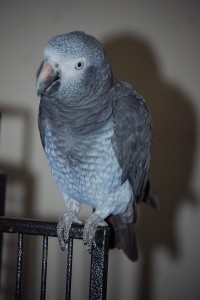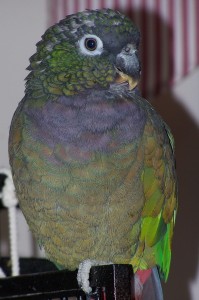systematic desensitization
Using Systematic Desensitization To Curb Pet Aggression
NOTE: I have a new pet behavior blog located at http://www.SoMuchPETential.com/blog. Thanks!
This is an inside look at how I used behavior analysis and systematic desensitization to work through a very serious behavior issue in my house. NOTE: this article was written for Hyde Park Living over a year ago.
It all began about six week s ago. Until then, my birds always had free access to their environment with their cage doors open whenever I’ve been at home. For the most part they’ve stayed on their own cages either napping or keeping busy with things I’ve given them; or Barnaby would fly onto his play cage in the other room.
s ago. Until then, my birds always had free access to their environment with their cage doors open whenever I’ve been at home. For the most part they’ve stayed on their own cages either napping or keeping busy with things I’ve given them; or Barnaby would fly onto his play cage in the other room.
And that is why, when I came upstairs to hear ‘Mommy here!’ coming from down the hall I initially thought it was just another day…until I saw Dreyfuss atop Barnaby’s cage. Dreyfuss chased Barnaby off his cage and that one bad decision set everything in motion.
Just the sight of Dreyfuss transformed Barnaby, my gentle teddy bear, into pure rage. (aggression not to me, only directed toward Dreyfuss) Barnaby flew at her like a hawk would fly after prey. I’ve never seen him behave like that. That day I kept both birds separated, and then ‘I’ made a bad decision. Barnaby really wanted back into his room and I thought I could allow him open cage time if Dreyfuss was in her cage with the door closed. Sadly, in a split second, Dreyfuss climbed the bars of her cage and Barnaby dove in, tearing Dreyfuss’s toe open.
OK, there was no more room for bad decisions. I had to come up with a game plan fast. Knowing that ‘positive practice makes perfect’ when it comes to any behavior, my short- term goal had to be preventing any situations that would create opportunities for Barnaby’s flying at Dreyfuss behavior. Every moment of every day that passes without Barnaby flying at Dreyfuss is a practice-free victory.
Remember those ABCs of behavior I’ve been talking about? Well, in this case the antecedents that predict Barnaby’s flying behavior included Dreyfuss being outside of her cage – whether sitting on her door, on top of her cage, or on my hand when Barnaby was within close proximity of less than six feet apart. Actually, when I analyzed it closely, there is a chain of ABCs. Those antecedents predicted Barnaby’s feathers to stand erect, his body to become taught, and his eyes to be pinned while being transfixed on Dreyfuss.
The ABC formula for this would be: (background scenario is that the birds are within six or seven feet from each other and usually in their own room) 1. Antecedent – Dreyfuss is outside her cage; Behavior – Barnaby’s feathers stand erect, his body becomes taught, and his eyes pin while being transfixed on Dreyfuss; Consequence – Dreyfuss stays where she is at. 2.) Antecedent – Dreyfuss stays where she is at; Behavior – Barnaby flies at her; Consequence – Dreyfuss gets knocked to the ground, injured or fights back.
As you can see, Barnaby clearly exhibited non aggressive body language that did not achieve a desired consequence, which escalated things to the aggressive flying behavior. By looking at the behavior in the context of its environment, the key to success here was to interrupt that chain. I had to work to 1) reduce or prevent circumstances as much as possible that would cause Barnaby to exhibit that body language to begin with and 2) if Barnaby did show any of that body language, I needed to empower him by allowing him to have a positive consequence from that nonaggressive behavior BEFORE it escalated.
The key to all of this was my being consistently and extremely aware at ALL times of Barnaby’s body language.
In the beginning when tension was at the extreme (when just the sight of Dreyfuss would set things in motion), I kept the two birds either in their cages or as far apart as they needed to be in order for Barnaby to be relaxed. And I never missed an opportunity to reinforce calm behavior with attention and/or food. (If they were out of their cages, one was in the tv room.)
Slowly I was able to carry Barnaby closer to Dreyfuss all the while going only at a pace that Barnaby’s body language told me he was comfortable with. As I walked with him on my arm, I continued to divert his attention with a lot of my attention. The second that I saw any sign of tensing up in his body, that was my cue to back up and start again. Scientifically this is called systematic desensitization, when you gradually expose an animal to a feared stimulus in small, incremental steps, never crossing the threshold into tense body language.
After some days when Barnaby was showing calm body language (not fixating on Dreyfuss, feathers down) while in the same room as Dreyfuss – in another area of the house – it was time to start working with them in their own room where the flying behavior is most likely to occur. Always in prevention mode, I let Barnaby out of his cage first and then gave him a few seeds before taking a step toward Dreyfuss’ door. I never took my eyes off Barnaby. If I noticed even one of those precursor behaviors just starting, I backed away from Dreyfuss’ cage. Again, slowly we got to where I opened her door and got her out. Then, as soon as she was out, I held her at arm’s length while giving Barnaby more attention for showing calm body language. Next, when we got to where Barnaby would step up on my other arm while I was holding Dreyfuss, I ignored her while talking to Barnaby.
Over time and positive repetitions, because I used only positive reinforcement while allowing Barnaby the power to make his own decisions, he no longer pins his eyes or gets taught when I let Dreyfuss out of her cage or pick her up and I can walk out of their room for short periods of time, while still in range.
I’m not sure if there will ever come a day when I can leave their cage doors open for hours at a time again (Barnaby does still need his exercise flying laps after all), but it sure is nice having peace again in our house.














